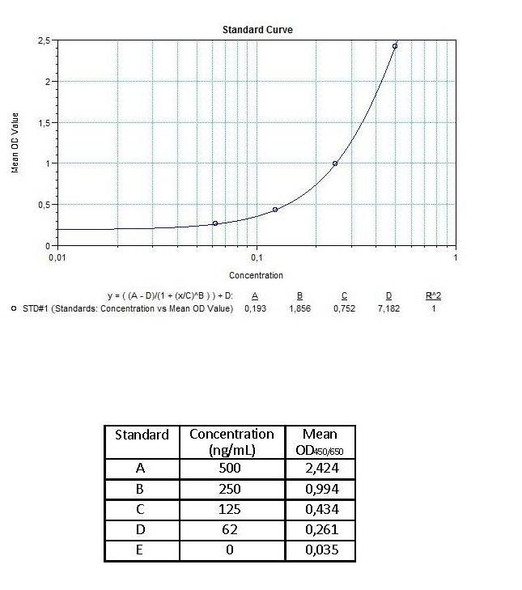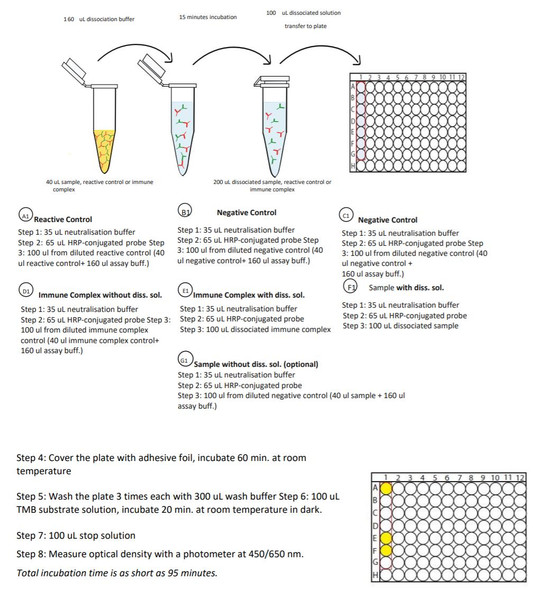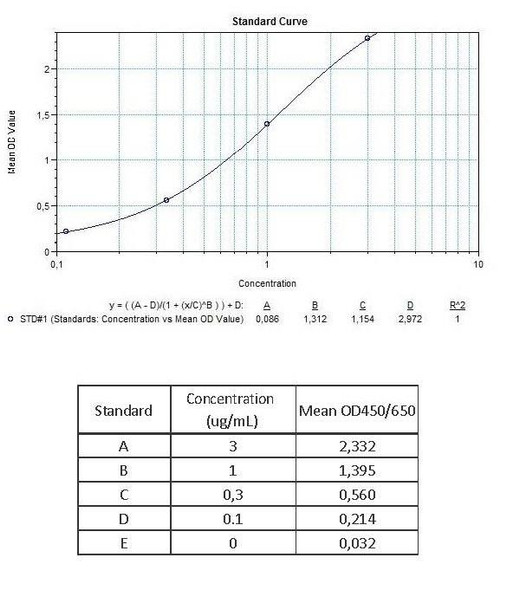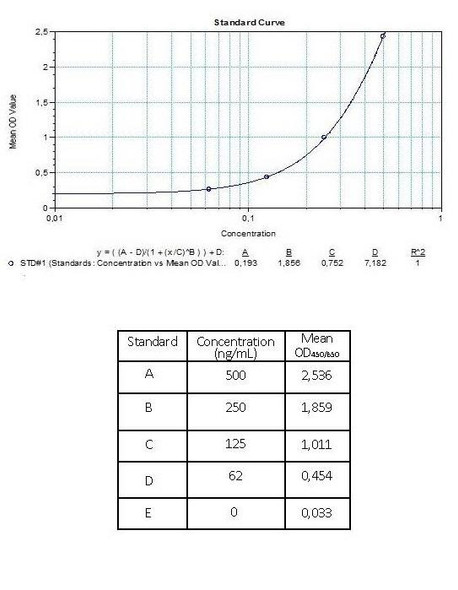Therapeutic Drug Monitoring
Infliximab (Remicade®) ELISA Kit
- SKU:
- HUMB00001
- Product Type:
- ELISA Kit
- ELISA Type:
- Biosimilar ELISA
- Biosimilar ELISA Type:
- Free drug
- Applications:
- ELISA
- Reactivity:
- Human
- Analytes:
- Infliximab (Remicade®)
- Research Area:
- Anti-TNF Alpha
Description
Infliximab ELISA Kit
Enzyme-linked immunosorbent assay (ELISA) for the quantitative determination of free Infliximab (Remicade®) therapeutic in serum and plasma. The Infliximab (Remicade®) ELISA Kit from Assay Genie has been especially developed for the quantitative analysis of free infliximab in serum and plasma samples.
Infliximab (Remicade®) ELISA Kit test principle
Solid phase enzyme-linked immunosorbent assay (ELISA) based on the sandwich principle. Standards and samples (serum or plasma) are incubated in the micro-titre plate coated with the reactant for infliximab (Remicade®). After incubation, the wells are washed. A horse radish peroxidase (HRP) conjugated probe is added and binds to infliximab captured by the reactant on the surface of the wells. Following incubation wells are washed and the bound enzymatic activity is detected by addition of chromogen-substrate. The colour developed is proportional to the amount of infliximab in the sample or standard. Results of samples can be determined directly using the standard curve.
| Information | Description |
Application | Free drug |
Required Volume (uL) | 10 |
Total Time (min) | 70 |
Sample Type | Serum, Plasma |
Number of Assays | 96 |
Detection Limit (ng/mL) | 100 (ng/ml) |
Spike Recovery (%) | 85-115 % |
Shelf Life (year) | 1 |
Alternative Names | Human Tumour Necrosis Factor Alpha Remicade |
Infliximab (Remicade®) - Key Information
Infliximab mode of action
Infliximab (Remicade®) is a chimeric monoclonal antibody and used to treat autoimmune disorders. Infliximab reduces the amount of active human tumour necrosis factor alpha (hTNF alpha) in the body by binding to it and preventing it from signalling the receptors for TNF alpha on the surface of various cell types. TNF alpha is one of the key cytokines that triggers and sustains the inflammatory reactions.
Infliximab uses
Infliximab is used for the treatment of psoriasis, Crohn’s disease, ankylosing spondylitis, psoriatic arthritis, rheumatoid arthritis, ulcerative colitis, and is approved by the FDA. Single intravenous (IV) infusions of 3 mg/kg to 20 mg/kg showed a linear relationship between the dose administered and the maximum serum concentration.
The volume of distribution at steady state was independent of dose and indicated that infliximab was distributed primarily within the vascular compartment. Median pharmacokinetic results for doses of 3 mg/kg to 10 mg/kg in rheumatoid arthritis and 5mg/kg in Crohn’s disease indicate that the terminal half-life of infliximab is 8.0 to 9.5 days.
In controlled trials, clinical response rates of 20-40% have been achieved with above- mentioned regimens in Crohn’s disease and rheumatoid arthritis. However, the therapeutic benefits must be balanced against the risk of a variety of severe adverse events (e.g. severe infections including tuberculosis, hepatotoxicity, infusion reactions, serum sickness-like disease and lymphoma). The volume of distribution of infliximab is low (3-6 L) and represents the intravascular space.
Infliximab treatment
Elimination of infliximab is most probably accomplished through degradation by unspecific proteases. It seemed that methotrexate delayed the decline in the serum concentrations of infliximab. When relating serum concentrations to the clinical response in patients, it can be assumed that through concentrations above 1mg/mL could be used as a kind of therapeutic target. The rate of clinical remission was higher for patients with a detectable trough serum infliximab compared with patients in whom serum infliximab was undetectable, including those without antibodies. A detectable trough serum infliximab was also associated with a lower C-reactive protein and a higher rate of endoscopic improvement.
For Crohn’s disease patients treated with scheduled maintenance infusions of infliximab, the serum concentration of infliximab seemed to predict clinical outcome. It was also proposed that, the surveillance of circulating infliximab concentration during maintenance therapy represents an indirect but reliable method to monitor anti-infliximab immunization. In this context, identification of biomarkers for (non-)response and risk factors for adverse drug reactions relating to serum concentrations and therapeutic drug monitoring of infliximab would be very helpful.
Infliximab ELISA Kit Contents
| Size | Kit contents |
1x12x8 | Microtiter Plate Break apart strips. Microtiter plate with 12 rows each of 8 wells coated with reactant |
7 x 0.3 mL | Infliximab Standards A-E, High Level Control, Low Level Control |
1 x 50 mL | Assay Buffer |
1 x 12 mL | Horse radish peroxidase-Conjugated Probe Red coloured. Ready to |
1 x 12 mL | TMB Substrate Solution. |
1 x 12 mL | TMB Stop Solution |
1 x 50 mL | Wash Buffer concentrate (20x) |
2 x 1 | Adhesive Foil |
Infliximab ELISA Kit Protocol
| Steps | Protocol |
1 | Pipette 100µl of Assay Buffer non-exceptionally into each of the wells to be used. |
2 | Pipette 10 µL of each ready-to use Standards, High Level Control, Low Level Control and Diluted Wells |
3 | Cover the plate with adhesive foil. Incubate 30 min at room temperature (18- 25°C). |
4 | Remove adhesive foil. Discard incubation solution. Wash plate 3 times each with 300 µL of diluted. Wash Buffer. Remove excess solution by tapping the inverted plate on a paper towel. |
5 | Pipette 100 µL of ready-to use HRP-Conjugated Probe into each well. |
6 | Cover the plate with adhesive foil. Incubate 30 min at room temperature (18- 25°C). |
7 | Remove adhesive foil. Discard incubation solution. Wash plate 3 times each with 300 µL of diluted Wash Buffer. Remove excess solution by tapping the inverted plate on a paper towel. |
8 | Pipette 100 µL of TMB Substrate Solution into each well. |
9 | Incubate 10 min (without adhesive foil) at room temperature (18-25°C) in the dark |
10 | Stop the substrate reaction by adding 100 µL of Stop Solution into each well. Briefly mix contents by gently shaking the plate. Colour changes from blue to yellow. |
11 | Measure optical density with a photometer at 450/650 nm within 30 min after pipetting of the Stop Solution. |
Trademarks
Remicade® is a registered trademark of Janssen Biotech Inc.






